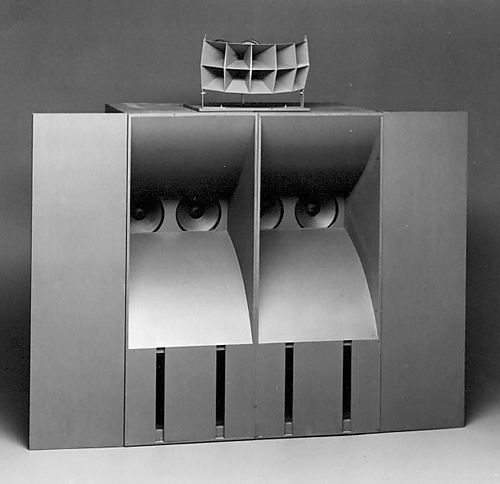Except for the side panels of A2, I'm not sure about that.TitaniumTroy said:as they look similar to the VOTT.

VOTT A2

VOTT A7
Both VOTT are port tuned for bass whereas the one you pointed out looks like horn loaded bass (bottom of cabinet).
Except for the side panels of A2, I'm not sure about that.TitaniumTroy said:as they look similar to the VOTT.


TitaniumTroy said:Thanks for the clarification SH, what was the reputation of it's sound quality, good, bad or just so-so? It looks like it should have plenty of scale
if nothing else.
TT, there is a small theater near LA that still uses VOTT. But the thing is, it's a private theater and the owner uses tube amps to power them up.TitaniumTroy said:It looks like it should have plenty of scale if nothing else.
DIYer said:I've heard that some old theaters in Nebraska and Iowa still use VOTT. It could have been a rumor and it was about 7 years ago so even if it was true, they are less likely be around now. I've seen old movie theaters around me close down last 10 years or so.
soundhound said:PaulyT said:SH, in that Altec cross section, it looks like the voice coil is not actually around (or inside) the stationary magnet? And it's hard to tell what actually moves in that diagram - looks like the whole voice coil+diaphragm are bolted to the "plate"...? Must be some freedom of movement somewhere - does the diaphragm move left/right in that picture? What is "tangential compliance"?
Sorry, just curious how this technology works, I've never really examined such a driver in detail.
The voice coil is in a pretty conventional magnetic gap. If you try to visualize the dome and voice coil as facing to the rear, facing away from the throat of the driver, then it more clear. Here is a page with the picture of an Altec 34647 diaphram, viewed from the part which is facing toward the rear of the compression driver (the voice coil is around the edge of the dome part, on the opposite side of the view).
The key part about the compression aspect is that the actual moving diaphram is larger than the mouth of the horn, so the wavefront is compressed at the throat of the horn. Compression ratios of 10:1 and more are common. Of course, the higher the compression, the more efficiency in the driver/horn combination. In the original picture I was referring to with the speaker at the end of a horn structure, there is NO compression because the speaker is the same size as the throat of the horn.
The importance of the phase plug is that it assures that sound wavefronts coming from all parts of the diaphram dome arrive at the throat in perfect phase. If there were no phase plug, the sound from the edges of the diaphram would arrive at the throat of the horn later than sound from the middle of the diaphram, and thus there would be phase cancellation at different frequencies. In low frequency horns, phase plugs are not needed because of the great length of the wave at bass frequencies means there is little phase difference between sound reaching the throat from the edge of the driver verses the center. Also, in horns where the driver is the same size as the throat of the horn there is no potential for phase cancellation so no phase plug is required.
But the presence of compression and horn structure is key to the vast advantage these devices have sonically over conventional speakers. In a proper compression driver / horn arrangement, the virtual "size" of the diaphram is multiplied, and the virtual "mass" of the diaphram is divided - plus on top of all this, distortion is drastically reduced. The net mass of the diaphram at the mouth of the horn can be less than the mass of the diaphram in electrostatic speakers, which are known for their fantastic transient response because of the low mass of their diaphram. A compression driver / horn combination can have less mass than even an electrostatic speaker, and thus even better transient response. It is this lighting fast transient response which gives these horns their realistic quality in reproducing sound, all the while having a vast dynamics advantage (because of their efficiency) which no other type of speaker can touch.
